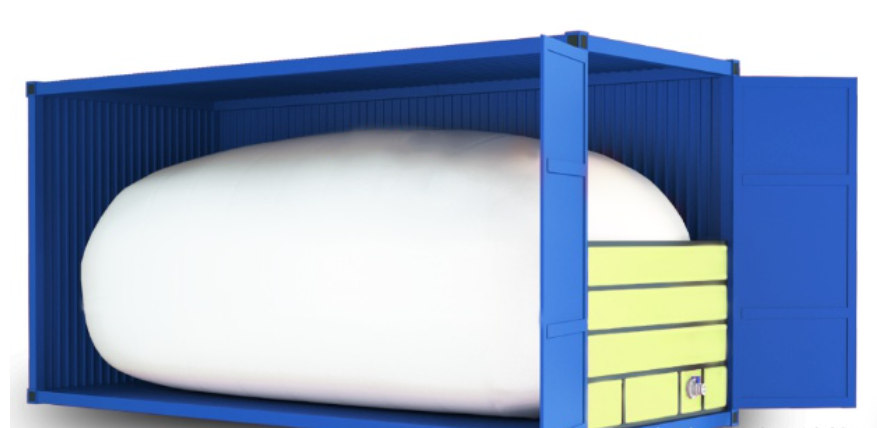Advantages of container flexitanks
Flexitank is a new type of flexible packaging container that can store and transport various non-dangerous liquid goods. It has more advantages than tank trucks. Each container can be placed in a 20-foot international standard container. Its volume is 14-24 cubic meters, and it can store and transport up to 24,000 liters of liquid. It is the most ideal way to use container transportation and is suitable for trains. Car, ship transportation.
1. Application scope of container flexitank:

1. Food: wine, edible oil, various concentrated fruit juices, food additives, sorbitol, palm oil, soy sauce, rice wine, mineral water, malt extract, various syrups, etc.
2. Various types of greases for industrial use: lubricating oil, lubricating oil additives, transformer oil, white oil, tung oil, glycerin, coconut oil, hydraulic oil, industrial gear oil, castor oil, high oil fatty acid, oleic acid, etc.
3. Non-hazardous liquid chemicals: plasticizers, synthetic resins, detergents, disinfectants, surfactants, polyols, feed additives, silicates, salt water solutions, propylene glycol, ethylene glycol, polyethers, alkylation agents, herbicides, fertilizers, natural rubber, synthetic latex, etc.
2. Advantages of flexitank shipping for export
It can replace expensive traditional packaging such as tanks and iron barrels, and can greatly reduce costs of loading, unloading, packaging, transportation and material management:
- Compared with ISO tank containers, each 20-foot container can save 30% of comprehensive logistics costs;
- Compared with IBC, each 20-foot container can save 40% of comprehensive logistics costs;
- Compared with iron drums, each 20-foot container can save 50% of comprehensive logistics costs
3. Let’s compare the advantages of container flexitanks in detail below.
(1) Flexitank VS. ISO TANK
1. The maximum volume of each flexitank container is 24,000 liters, which is the same as a tank container. However, the shipping cost is calculated based on an ordinary 20-foot international standard container. Compared with the high shipping cost of a tank container, it has obvious advantages.
2. The supply and distribution of tank containers are subject to many conditions, which often affect customers’ normal import and export plans. Coupled with the higher inland ferry container fees and loading and unloading fees, the burden on customers is even heavier. However, flexitanks are not affected by supply, distribution, geography and environment. They have no inland ferry fees, are small in size, are easy to transport, and are convenient, efficient and safe to load and unload.
3. The rental fee of tank containers (about 15 US dollars per day), the return fee and the cleaning fee (about 200 US dollars) also put too much unnecessary financial burden on customers, but there is no need for such expenses with flexitanks. , greatly saving shipping costs for customers.
4. Compared with the tight supply and space of tank containers, the use of flexitanks for transportation eliminates the need to consider the shortage of space and space, which further ensures customers' on-time import and export plans and reduces customer operating costs.

(2) Flexitank VS. 200L iron drum
1. Each 20-foot international standard container can ship up to 80 pieces of 200 liters of iron. Calculated at 150-200 yuan per iron drum, the packaging cost of each container shipment is 12,000-16,000 yuan. Currently, each container The prices of flexitanks are much lower than the total price of 80 iron drums, and only the packaging cost has been significantly reduced.
2. If we also consider that each 20-foot international standard container can be loaded with a maximum of 17,600 liters in an iron drum, but can be loaded with a maximum of 24,000 liters using a container flexitank, the freight required to be paid on the basis of drum packaging remains unchanged, but it can An extra 6,400 liters of goods can be loaded; in other words, the goods that originally required 4 containers can now be shipped in 3 containers, saving the transportation cost and packaging cost of 1 container, and the unit freight cost has been reduced a lot.
3. In addition, flexitanks are easy to operate. Two people can easily complete all loading and unloading work in just one hour, completely eliminating the complicated operating procedures, manpower, working hours, required materials, etc. required for barreled goods. expenditures.
(3) Flexitank VS. 1000L IBC
First of all, the procurement cost of IBC barrels is high. Each IBC barrel can hold up to about 1.2 tons. Each 20-foot international standard container can ship up to 18 IBC barrels. Calculated at 1,200 yuan per IBC barrel, one container of goods is shipped each time. The packaging cost is 21,600 yuan, and the current price of each container of flexitank is much lower than the total price of 18 IBC barrels. Only the packaging cost has been significantly reduced.
Secondly, the shipping capacity of IBC barrels is limited. Each 20-foot international standard container can be shipped with a maximum of 21,600 liters in an IBC barrel, while a container flexitank can be loaded with a maximum of 24,000 liters. The freight required to be paid based on the IBC barrel remains unchanged. , but can carry an additional 2,400 liters of goods, and the unit freight cost is greatly reduced.
Thirdly, loading and unloading IBC barrels requires forklifts and other equipment, and the loading and unloading process takes a long time. However, the loading and unloading of flexitanks does not require any mechanical equipment. It only takes two people and only one hour to complete the operation, which can not only reduce the customer's loading and unloading costs. , but also save a lot of time for customers.

Tel.: +86 17864390557





